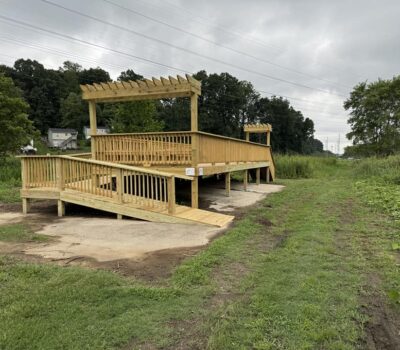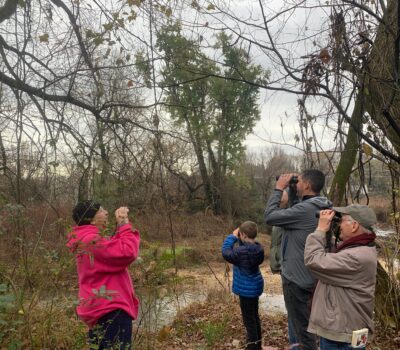Ask a Naturalist: Think “Railroad” When Birding
Did you know that there is a new accessible birding platform at Gateway Nature Preserve? Visit the southern meadow area to access the platform and see how many of the following birds you can observe and hear.
It has occurred to me that watching for birds and watching for a train at a railroad crossing are very similar. In both cases the instructions are STOP, LOOK, and LISTEN. That’s what you ought to do both at a railroad track, to avoid disaster, and along the Greenway in the Gateway Nature Preserve, to see and hear wonderful things.
Here are six of the most likely feathered vocalists you may come upon at the GNP:
The Carolina Wren is a tiny brown bird with a thin white line over its eye and a very loud call. It “shouts” a repeated phrase, usually three times, that has been described as tea-kettle, tea-kettle, tea-kettle. I hear it as video, video, video. Although it is the state bird of South Carolina, it is especially common in our state and at the GNP.
The Northern Cardinal (our state bird) is a bright red bird (male) or tan-brown bird with a bright red-orange bill (female). Both have a characteristic crest. Its distinctive song is clear, upward-sweeping slurred whistles that may be slow and fast.
The American Robin is a medium-sized plump-breasted thrush with a dark gray back and red-orange (rufous) breast. It is commonly seen searching for worms on lawns everywhere. It has a distinctive bright, caroling song that sounds like cheerio, cheerio, cheerio.
The Eastern Towhee looks very much like the robin but with a thicker, finch-like bill and a white belly, rufous sides and black back. Its found in the woods rather than on lawns. It has an unmistakable song: Drink-your-teeee.
The Tufted Titmouse is a small, gray bird with a distinctive pointed crest on its head. It roams the woods, often two together, and calls a clear peter, peter, peter or here, here, here.
The American Crow, a big, black bird often traveling with a few other companions. It has that distinctive caw, caw call that we all know.
Why do birds make these calls and songs? Sometimes to stake out territory during the nesting season. Other times to keep in touch with each other or warn of some danger (a hawk or snake may be near).
There are many other birds with distinctive calls and songs. So get out to the Gateway Nature Preserve. STOP, LOOK, and especially LISTEN.
Incidentally, there are Barn Swallows nesting under the Broad Street bridge over Salem Creek. They are easy to see from the Greenway and when excited make an anxious twittering sound. So don’t stay too long.
(Note: One of the best places to see pictures of these birds and additional information on their calls, songs, habits and distribution is to go to www.allaboutbirds.org.)


